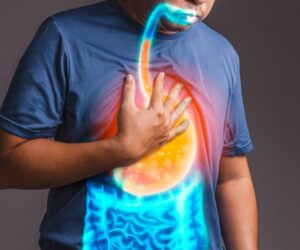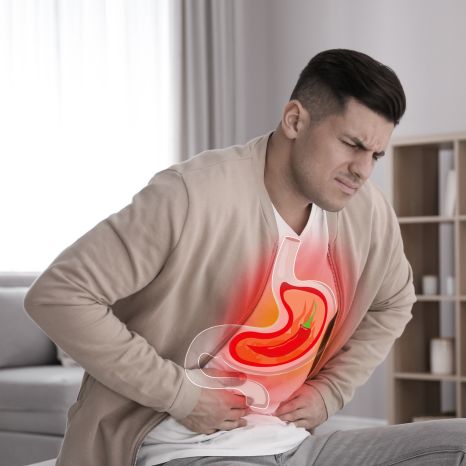Everything to know about stomach pain and nausea
Welcome to our comprehensive guide on nausea and stomach pain. On this page, we’ll delve into the various causes, symptoms, and remedies for these common digestive issues.
Everything to know about stomach pain and nausea
Welcome to our comprehensive guide on nausea and stomach pain. On this page, we’ll delve into the various causes, symptoms, and remedies for these common digestive issues.

What is acid reflux?
A common digestive disorder characterised by the backward flow of stomach acid into the oesophagus is acid reflux, also known as gastroesophageal reflux disease (GERD). This occurs when the lower oesophagal sphincter (LES), a muscular ring at the junction of the oesophagus and stomach, relaxes inappropriately or weakens.
Acid reflux affects millions of people worldwide, with a significant portion experiencing symptoms regularly. Over the years, various factors, such as dietary habits, lifestyle choices, and obesity, have increased the incidence of acid reflux.
What is acid reflux?
A common digestive disorder characterised by the backward flow of stomach acid into the oesophagus is acid reflux, also known as gastroesophageal reflux disease (GERD). This occurs when the lower oesophagal sphincter (LES), a muscular ring at the junction of the oesophagus and stomach, relaxes inappropriately or weakens.
Acid reflux affects millions of people worldwide, with a significant portion experiencing symptoms regularly. Over the years, various factors, such as dietary habits, lifestyle choices, and obesity, have increased the incidence of acid reflux.

What are the symptoms of acid reflux?
In addition, certain individuals may have unusual symptoms like asthma, teeth erosion, or persistent coughs that can also be signs of acid reflux.

Heartburn
A burning sensation in the chest, often accompanied by a sour or bitter taste in the mouth.

Regurgitation
The sensation of acid or food coming back up into the throat or mouth, which can have a sour taste.

Chest pain
Chest pain or discomfort that mimics heart-related issues, where pain can range from mild to severe.

Difficulty swallowing
Dysphagia may occur due to irritation or narrowing of the oesophagus caused by chronic acid exposure.

Chronic cough
A cough unrelated to respiratory conditions, which is worse and persistent at night or after meals.

Sore throat
Acid reflux can irritate the throat, leading to a persistent sore throat, hoarseness, or a sensation of a lump in the throat.

Nausea
Individuals experience nausea or an upset stomach when acid reflux triggers the vomiting reflex.

Excessive salivation
Increased production of saliva, especially before or after meals, may occur in response to acid reflux.
It is important to talk to your doctor for appropriate evaluation and treatment if you experience recurrent or serious acid reflux symptoms.

What is the importance of understanding symptoms?
Recognising the symptoms of acid reflux, including stomach pain and nausea, is crucial for early detection and management of the condition. While heartburn is the most common symptom associated with acid reflux, nausea and stomach pain can also occur and may indicate more severe forms of the disease. Understanding these symptoms helps individuals seek appropriate medical attention, receive timely diagnosis, and implement effective treatment strategies to alleviate discomfort and prevent complications.
In the following sections, we’ll delve deeper into the mechanisms of acid reflux, its symptoms, diagnosis, treatment options, and preventive measures to empower individuals in managing their digestive health effectively.
What is the digestive process and how does acid reflux disrupt it?
The digestive process is a complex series of events that begins with the ingestion of food and ends with the absorption of nutrients and elimination of waste.
As food is consumed through the mouth, ingestion starts the process. Chewing breaks down the food into smaller pieces that form a bolus, which is easier to swallow. Then the bolus is pushed into the back of your throat, passing through an esophageal tube that connects your mouth to your stomach. The swallowing reflex is used to facilitate this movement.
The bolus is carried by a series of coordinated contractions known as peristalsis down the gastrointestinal tract. To prevent stomach contents from returning to the oesophagus, the lower esophageal sphincter, a ring of muscles at the junction of the oesophagus and the stomach is normally closed.
The LES is relaxed when it reaches the stomach so that a bolus can be administered. Gastric juices, including hydrochloric acid and enzymes that help break down the food to kill bacteria, are found in your stomach. The food in the stomach is mixed with gastric juices, which are converted to a semiliquid mixture known as chyme. To continue digestion and absorption of nutrients, the mixture is slowly removed from the small intestine.
The chyme nutrients are absorbed into the bloodstream in the small intestine using intestinal walls. They also absorb water and electrolytes and leave behind waste products. In the large intestine, where water and electrolytes are reabsorbed, waste products, undigested food particles or bacteria pass. Through bowel movements, the rest of the waste is removed from the body.
In particular, acid reflux causes a backward flow of gastric acid and food from the stomach to the oesophagus. This reflux of acidic contents irritates the lining of the oesophagus, leading to inflammation and symptoms such as heartburn, regurgitation, and chest pain.
Acid reflux disturbs the natural barrier that prevents the stomach contents from refluxing into the oesophagus, causing discomfort and possible damage to the oesophagal lining, by interfering with the normal functioning of the LES.


What is the importance of understanding symptoms?
Recognising the symptoms of acid reflux, including stomach pain and nausea, is crucial for early detection and management of the condition. While heartburn is the most common symptom associated with acid reflux, nausea and stomach pain can also occur and may indicate more severe forms of the disease. Understanding these symptoms helps individuals seek appropriate medical attention, receive timely diagnosis, and implement effective treatment strategies to alleviate discomfort and prevent complications.
In the following sections, we’ll delve deeper into the mechanisms of acid reflux, its symptoms, diagnosis, treatment options, and preventive measures to empower individuals in managing their digestive health effectively.



What is the digestive process and how does acid reflux disrupt it?
The digestive process is a complex series of events that begins with the ingestion of food and ends with the absorption of nutrients and elimination of waste.
As food is consumed through the mouth, ingestion starts the process. Chewing breaks down the food into smaller pieces that form a bolus, which is easier to swallow. Then the bolus is pushed into the back of your throat, passing through an esophageal tube that connects your mouth to your stomach. The swallowing reflex is used to facilitate this movement.
The bolus is carried by a series of coordinated contractions known as peristalsis down the gastrointestinal tract. To prevent stomach contents from returning to the oesophagus, the lower esophageal sphincter, a ring of muscles at the junction of the oesophagus and the stomach is normally closed.
The LES is relaxed when it reaches the stomach so that a bolus can be administered. Gastric juices, including hydrochloric acid and enzymes that help break down the food to kill bacteria, are found in your stomach. The food in the stomach is mixed with gastric juices, which are converted to a semiliquid mixture known as chyme. To continue digestion and absorption of nutrients, the mixture is slowly removed from the small intestine.
The chyme nutrients are absorbed into the bloodstream in the small intestine using intestinal walls. They also absorb water and electrolytes and leave behind waste products. In the large intestine, where water and electrolytes are reabsorbed, waste products, undigested food particles or bacteria pass. Through bowel movements, the rest of the waste is removed from the body.
In particular, acid reflux causes a backward flow of gastric acid and food from the stomach to the oesophagus. This reflux of acidic contents irritates the lining of the oesophagus, leading to inflammation and symptoms such as heartburn, regurgitation, and chest pain.
Acid reflux disturbs the natural barrier that prevents the stomach contents from refluxing into the oesophagus, causing discomfort and possible damage to the oesophagal lining, by interfering with the normal functioning of the LES.


What are the causes of acid reflux?
Dietary factors
Foods and beverages have been identified as common triggers or exacerbations of acid reflux symptoms. These include spicy foods, acidic foods, caffeine, and alcohol.
Spicy foods may irritate the lining of the gastrointestinal tract and exacerbate the symptoms of acid reflux. In individuals who are prone to acid reflux, the heat and spice of these foods may cause discomfort and heartburn.
Acid foods, such as citrus fruits, tomatoes, and sauces made with vinegar are high in acid, which may contribute to the symptoms of acid reflux. The acidity of these foods can irritate the stomach and make it more likely that you will have heartburn or regurgitations.
In a variety of beverages, including coffee, tea, soda, and energy drinks, caffeine is present. Caffeine has been found to improve the relaxation of the lower LES sphincter, a muscle valve that separates the oesophagus from the stomach. When the LES relaxes, stomach acid may be more able to pass through the oesophagus and lead to symptoms of acid regurgitation.
Alcoholic beverages can also relax the LES and increase stomach acid production, making individuals more susceptible to acid reflux. Additionally, alcohol can irritate the lining of the oesophagus, exacerbating symptoms such as heartburn and regurgitation.
It may be helpful for people to know the possible triggers of acid reflux, such as spicy food, acidic foods, caffeine, and alcoholic beverages so that they can make more accurate dietary choices to cope with their symptoms. Individuals may be able to decrease the frequency and severity of their symptoms of acid reflux by avoiding or reducing consumption of these trigger foods and beverages.
Lifestyle factors
Certain lifestyle habits can play a significant role in increasing the risk of developing acid reflux. These factors include obesity, smoking, and stress.
Obesity is a major risk factor for acid reflux. Excess body weight puts pressure on the abdomen, which can lead to the displacement of stomach contents and increase the likelihood of acid reflux. This pressure can cause the lower oesophagal sphincter (LES) to weaken or relax, allowing stomach acid to flow back into the oesophagus.
Smoking is a lifestyle factor that can contribute to acid reflux. Tobacco smoke contains chemicals that weaken the LES and impair the function of the oesophagus. Smoking also increases the production of stomach acid, further exacerbating the risk of acid reflux. Additionally, smoking can damage the oesophagal lining, making it more susceptible to irritation and inflammation.
Stress has a significant impact on digestive health, including the development and exacerbation of acid reflux symptoms. Psychological stress can trigger or exacerbate digestive symptoms by altering gastric acid secretion and gastrointestinal motility. Stress can also lead to behaviours such as overeating or poor dietary choices, which can further contribute to acid reflux.
Understanding the role of lifestyle factors such as obesity, smoking, and stress in the development of acid reflux is crucial for effectively managing the condition. By making positive lifestyle changes, such as maintaining a healthy weight, quitting smoking, and practising stress-reduction techniques, individuals can reduce their risk of experiencing acid reflux symptoms and improve their overall digestive health.
Medical conditions
Understanding the potential causes of acid reflux is essential for identifying triggers and implementing effective strategies to manage and prevent symptoms. Two underlying medical conditions that can contribute to the development of acid reflux are hiatal hernia and gastroparesis.
Managing hiatal hernia-related acid reflux involves a combination of dietary changes, weight management, and lifestyle modifications. Avoiding large meals and acidic or spicy foods and lying down after eating can help minimise discomfort and reduce the risk of reflux. Elevating the head of the bed while sleeping can also prevent stomach acid from refluxing into the oesophagus at night.
Gastroparesis is a condition characterised by delayed gastric emptying, in which the stomach takes longer than usual to empty its contents into the small intestine. This delay can lead to an accumulation of stomach contents and increase the likelihood of acid reflux.
Following a low-fibre, low-fat diet consisting of smaller, more frequent meals can help alleviate symptoms and reduce the risk of reflux. Lifestyle changes, such as eating slowly, chewing food thoroughly, and staying upright after meals, can also facilitate digestion and reduce symptoms.
Addressing underlying medical conditions such as hiatal hernia and gastroparesis, individuals can effectively manage acid reflux symptoms, such as stomach pain and nausea, and improve their overall digestive health. It’s important to work closely with a healthcare specialist to develop a personalised treatment plan and make necessary dietary and lifestyle modifications to reduce the risk of experiencing gastroesophageal reflux.
Tight-fitting clothing
Wearing tight-fitting clothing, particularly around the abdomen, can exacerbate acid reflux symptoms by increasing pressure on the stomach and LES.
Tight clothing can constrict the abdominal area, compressing the stomach and other digestive organs. This compression raises intra-abdominal pressure, forcing stomach acid to reflux into the oesophagus. The increased pressure on the LES weakens its ability to maintain closure, allowing acid to flow upward more easily.
When the stomach is compressed by tight clothing, it may take longer for food to pass through and empty into the small intestine. This delay can prolong the exposure of the oesophagus to stomach acid, increasing the risk of acid reflux symptoms.
Wearing tight clothing can cause physical discomfort and indigestion, which may exacerbate acid reflux symptoms. Tight waistbands or belts can create pressure on the stomach, leading to feelings of fullness, bloating, or discomfort after meals. These sensations can trigger or worsen reflux symptoms, particularly if the LES is already weakened or compromised.
Opting for loose-fitting clothing can help alleviate pressure on the abdomen and reduce the risk of acid reflux symptoms. Loose clothing allows the stomach to expand and contract naturally during digestion, minimising intra-abdominal pressure and promoting normal gastric motility. By choosing non-restrictive attire, individuals can support healthy digestion and reduce the likelihood of experiencing acid reflux discomfort.
Making simple changes in clothing choices can complement other lifestyle modifications and contribute to the effective management of acid reflux.
Why should you consult a doctor for stomach pain and nausea?
Nausea and stomach pain can be symptoms of various underlying medical conditions, some of which can be serious, so it’s vital to know the underlying cause.
Nausea and stomach pain can be caused by a wide range of conditions, including gastritis, gastroenteritis, ulcers, food poisoning, appendicitis, gallstones, and many others. A healthcare specialist can help diagnose the specific cause through a thorough medical history, physical examination, and possibly diagnostic tests such as blood tests, imaging studies, or endoscopy.
Appropriate treatment may be required once the cause of nausea and stomach pain has been established. Depending on the underlying condition, this can involve medicines, dietary changes, lifestyle modifications, or some kind of surgery.
Some conditions that cause nausea and stomach pain can lead to serious complications if left untreated. For example, appendicitis can progress to a ruptured appendix, which can be life-threatening. Seeking prompt medical attention can help prevent such complications.
The quality of life may be significantly affected by nausea and stomach pain even if the underlying cause is not immediately serious. To help reduce these symptoms and improve their comfort, healthcare professionals may prescribe medicinal products or other interventions.
In some cases, nausea and stomach pain are gastrointestinal symptoms of chronic conditions such as gastroesophageal reflux disease (GERD). Regular monitoring by a healthcare provider can help manage these conditions and prevent flare-ups. It is important to consult a healthcare specialist for nausea and stomach pain to identify the underlying cause, receive appropriate treatment, prevent complications, relieve symptoms or ensure overall good health.



Why should you consult a doctor for stomach pain and nausea?
Nausea and stomach pain can be symptoms of various underlying medical conditions, some of which can be serious, so it’s vital to know the underlying cause.
Nausea and stomach pain can be caused by a wide range of conditions, including gastritis, gastroenteritis, ulcers, food poisoning, appendicitis, gallstones, and many others. A healthcare specialist can help diagnose the specific cause through a thorough medical history, physical examination, and possibly diagnostic tests such as blood tests, imaging studies, or endoscopy.
Appropriate treatment may be required once the cause of nausea and stomach pain has been established. Depending on the underlying condition, this can involve medicines, dietary changes, lifestyle modifications, or some kind of surgery.
Some conditions that cause nausea and stomach pain can lead to serious complications if left untreated. For example, appendicitis can progress to a ruptured appendix, which can be life-threatening. Seeking prompt medical attention can help prevent such complications.
The quality of life may be significantly affected by nausea and stomach pain even if the underlying cause is not immediately serious. To help reduce these symptoms and improve their comfort, healthcare professionals may prescribe medicinal products or other interventions.
In some cases, nausea and stomach pain are gastrointestinal symptoms of chronic conditions such as gastroesophageal reflux disease (GERD). Regular monitoring by a healthcare provider can help manage these conditions and prevent flare-ups. It is important to consult a healthcare specialist for nausea and stomach pain to identify the underlying cause, receive appropriate treatment, prevent complications, relieve symptoms or ensure overall good health.



FAQs
Why do I feel nauseous and why does my stomach hurt?
Various factors, such as stomach infections, food poisoning, indigestion, heartburn, gastritis, ulcers, acid, or any of the underlying medical conditions, may cause nausea and pain in the stomach.
When should I worry about stomach pain and nausea?
You should consider seeking medical attention if your nausea and stomach pain are severe, persistent, accompanied by other concerning symptoms such as vomiting blood, fever, or difficulty breathing, or if they interfere significantly with your daily activities and quality of life. Additionally, if you have a pre-existing medical condition or are pregnant, it’s advisable to consult a healthcare professional promptly.
When should I go to the ER for nausea and stomach pain?
You should consider going to the emergency room for nausea and stomach pain if you experience severe or sudden abdominal pain, especially if it’s accompanied by symptoms like vomiting blood, high fever, difficulty breathing, fainting, or signs of dehydration such as excessive thirst, decreased urination, or dizziness. If you have a pre-existing medical condition that puts you at higher risk, or if you’re pregnant and experiencing nausea and stomach pain, it’s also wise to seek urgent medical attention.
